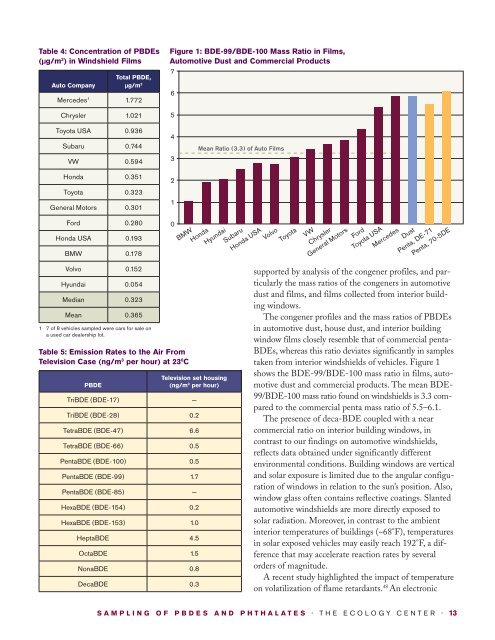Chemicals in cars and the need for safe alternatives
Chemicals in cars and the need for safe alternatives
Chemicals in cars and the need for safe alternatives
You also want an ePaper? Increase the reach of your titles
YUMPU automatically turns print PDFs into web optimized ePapers that Google loves.
table : Concentration of Pbdes<br />
(μg/m 2 ) <strong>in</strong> w<strong>in</strong>dshield Films<br />
Auto Company<br />
total Pbde,<br />
μg/m 2<br />
Mercedes 1 1.772<br />
Chrysler 1.021<br />
Toyota USA 0.936<br />
Subaru 0.744<br />
VW 0.594<br />
honda 0.351<br />
Toyota 0.323<br />
General Motors 0.301<br />
Ford 0.280<br />
honda USA 0.193<br />
BMW 0.178<br />
Volvo 0.152<br />
hyundai 0.054<br />
Median 0.323<br />
Mean 0.365<br />
1 7 of 8 vehicles sampled were <strong>cars</strong> <strong>for</strong> sale on<br />
a used car dealership lot.<br />
table : emission rates to <strong>the</strong> Air From<br />
television Case (ng/m per hour) at 2 0 C<br />
Pbde<br />
Figure 1: bde- /bde-100 mass ratio <strong>in</strong> Films,<br />
Automotive dust <strong>and</strong> Commercial Products<br />
7<br />
6<br />
5<br />
4<br />
3<br />
2<br />
1<br />
0<br />
television set hous<strong>in</strong>g<br />
(ng/m per hour)<br />
TriBDE (BDE-17) —<br />
TriBDE (BDE-28) 0.2<br />
TetraBDE (BDE-47) 6.6<br />
TetraBDE (BDE-66) 0.5<br />
PentaBDE (BDE-100) 0.5<br />
PentaBDE (BDE-99) 1.7<br />
PentaBDE (BDE-85) —<br />
hexaBDE (BDE-154) 0.2<br />
hexaBDE (BDE-153) 1.0<br />
heptaBDE 4.5<br />
octaBDE 1.5<br />
NonaBDE 0.8<br />
DecaBDE 0.3<br />
mean ratio (3.3) of Auto films<br />
BMW<br />
honda<br />
hyundai<br />
Subaru<br />
honda USA<br />
Volvo<br />
Toyota<br />
VW<br />
Chrysler<br />
General Motors<br />
Ford<br />
Toyota USA<br />
Mercedes<br />
Dust<br />
Penta, DE-71<br />
Penta, 70-5DE<br />
supported by analysis of <strong>the</strong> congener profiles, <strong>and</strong> particularly<br />
<strong>the</strong> mass ratios of <strong>the</strong> congeners <strong>in</strong> automotive<br />
dust <strong>and</strong> films, <strong>and</strong> films collected from <strong>in</strong>terior build<strong>in</strong>g<br />
w<strong>in</strong>dows.<br />
<strong>the</strong> congener profiles <strong>and</strong> <strong>the</strong> mass ratios of pBDes<br />
<strong>in</strong> automotive dust, house dust, <strong>and</strong> <strong>in</strong>terior build<strong>in</strong>g<br />
w<strong>in</strong>dow films closely resemble that of commercial penta-<br />
BDes, whereas this ratio deviates significantly <strong>in</strong> samples<br />
taken from <strong>in</strong>terior w<strong>in</strong>dshields of vehicles. Figure 1<br />
shows <strong>the</strong> BDe-99/BDe-100 mass ratio <strong>in</strong> films, automotive<br />
dust <strong>and</strong> commercial products. <strong>the</strong> mean BDe-<br />
99/BDe-100 mass ratio found on w<strong>in</strong>dshields is 3.3 compared<br />
to <strong>the</strong> commercial penta mass ratio of 5.5–6.1.<br />
<strong>the</strong> presence of deca-BDe coupled with a near<br />
commercial ratio on <strong>in</strong>terior build<strong>in</strong>g w<strong>in</strong>dows, <strong>in</strong><br />
contrast to our f<strong>in</strong>d<strong>in</strong>gs on automotive w<strong>in</strong>dshields,<br />
reflects data obta<strong>in</strong>ed under significantly different<br />
environmental conditions. Build<strong>in</strong>g w<strong>in</strong>dows are vertical<br />
<strong>and</strong> solar exposure is limited due to <strong>the</strong> angular configuration<br />
of w<strong>in</strong>dows <strong>in</strong> relation to <strong>the</strong> sun’s position. Also,<br />
w<strong>in</strong>dow glass often conta<strong>in</strong>s reflective coat<strong>in</strong>gs. slanted<br />
automotive w<strong>in</strong>dshields are more directly exposed to<br />
solar radiation. moreover, <strong>in</strong> contrast to <strong>the</strong> ambient<br />
<strong>in</strong>terior temperatures of build<strong>in</strong>gs (~68°F), temperatures<br />
<strong>in</strong> solar exposed vehicles may easily reach 192°F, a difference<br />
that may accelerate reaction rates by several<br />
orders of magnitude.<br />
A recent study highlighted <strong>the</strong> impact of temperature<br />
on volatilization of flame retardants. 48 An electronic<br />
s A m P l i n g o F P b d e s A n d P h t h A l A t e s • T h E E C o l o G Y C E N T E R • 1

















